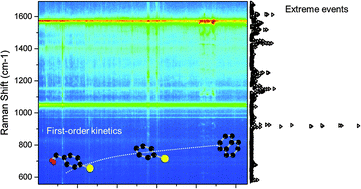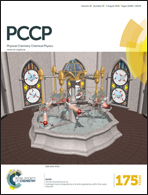Dynamics of a plasmon-activated p-mercaptobenzoic acid layer deposited over Au nanoparticles using time-resolved SERS†
Abstract
Time-dependent SERS intensity recorded over a drop-coated coffee-ring pattern of p-MBA with gold colloids was investigated as a function of the specific laser power applied. Pure electromagnetic enhancement produced stochastic intensity variations of the whole SER spectra, which were mainly correlated with evolutions of the background intensity. Besides long-term, non-reversible spectral changes caused by plasmon-induced decarboxylation of p-MBA, transient original spectral profiles showing additional lines were also observed as the specific power reached 5.5 × 104 W cm−2. An unprecedented qualitative and quantitative study of SERS intensity variations based on the complementary use of both extreme deviation and cross-correlation statistics is provided, which resulted in an improved understanding of SERS mechanisms. More precisely, cross-correlation analysis made it possible to follow the evolution of groups of modes assigned to one species or sharing the same symmetry while so-called individual events denote particular resonance structures, whose occurrence was tentatively related to a photo-thermally activated motion of the gold nanostructures.


 Please wait while we load your content...
Please wait while we load your content...